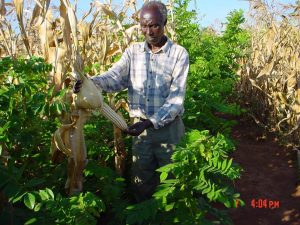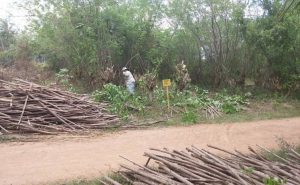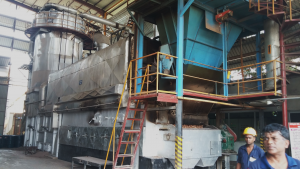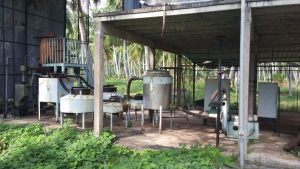The fight against climate change has just become much more urgent and critical. The latest report by the hundreds of scientists making up the Intergovernmental Panel on Climate Change (IPCC), released late last year, makes two things very stark and clear:
1st, if we don’t immediately ramp up efforts to decarbonize the entire global economy, and bring down the rate of carbon pollution in the atmosphere drastically during the next decade, we will overshoot the global targets and soon enter the realm of climate catastrophe. This will require a rapid global transformation away from fossil fuels, one that is much more rapid than previously anticipated. We must totally change the ways that we generate our energy, run our vehicles, grow our food and manufacture our products.
2nd, these measures on their own — however rapidly they accelerate — will still not be enough to prevent the consequences of catastrophic climate change. We must now proceed well beyond even this, and recapture very large quantities of carbon back out of the air. All of the pathways projected to limit global warming now rely on massive carbon removal from the air. Or else, the extreme heat waves, and severe droughts, that are already causing havoc in many parts of the world right now, will soon be drastically worse.
The IPCC warnings on all this have become progressively more dire. But it is also good to keep in mind that this body has always tended to be pretty conservative in its predictions. It has consistently underestimated the pace of climate change, partly because their reports rely on consensus, and they tend to lag by some years the most recent climate science results. The data collected since 2014 is pointing to accelerating temperature changes that no longer correlate with the rate of carbon emissions alone. This suggests that there are other feedback loops that are kicking in. These would ensure that the impacts going forward will be far more rapid and severe than the current IPCC predictions.
What’s happening in the Arctic?
Global temperatures have increased by 0.9° Celsius since 1880. The greatest warming is in the Arctic, where the 2016 land surface temperature was 2.0°C above the 1981-2010 average, breaking all previous records. This was a 3.5°C increase since the record began in 1900 (AaronMorrison et al, 2017). At one point in early 2018, temperature recordings from the Arctic were 20 degrees C above the average for that date (Watts, 2018). The warming of the Arctic has been destabilizing winds in the higher atmosphere, leading to extreme movements of warmer air north into the Arctic, melting the ice at massive rates, and movements of very cold air to the south into Europe and North America, causing frigid wintertime conditions.
The warming Arctic has led to a dramatic loss in sea ice, over two-thirds of which has disappeared since 1980. The reduction in Artic sea ice has increased the rate of global warming because the darker sea water absorbs more of sun’s rays than does the ice itself. In fact, we could now remove a quarter of the cumulative CO2 emissions of the last three decades, and it would still be outweighed simply by the loss of the reflective power of Arctic sea ice that has already occurred (Pistone et al, 2014). The observed phenomena, of actual temperatures and sea levels, are greater than what the IPCC climate models have been predicting.
An ice-free Arctic, which could occur one summer in the next few years, will likely increase by 50% the warming caused by the CO2 produced by human activity (Wadhams, 2016). That in itself, would render the negative predictions of the IPCC too far too conservative, along with the targets and proposals of the UNFCCC.
The IPCC agreed in 2013 that if the world does not keep further emissions below a total of 800 billion tonnes of carbon we are not likely to keep average temperatures below 2 degrees of global averaged warming. That left about 270 billion tonnes of carbon to burn (Pidcock, 2013). Total global emissions remain at around 11 billion tonnes of carbon per year (which is 37 billion tonnes of CO2). But carbon emissions continued to increase in 2017 by an additional 2%. We are not yet even making a serious dent in global emissions (Canadell et al, 2017). Some scientists estimate that the existing CO2 in the atmosphere will already produce global ambient temperature rises over 5°C (Wasdell, 2015); so, there is no carbon budget left – it has already been overspent. This is serious stuff.
Then there is the methane story
On top of all this is evidence that the release of methane into the atmosphere is now accelerating rapidly. Methane gas enables far more trapping of heat from the sun’s rays than CO2, but this source has been ignored in most of the climate models. In the early 2000s the concentrations of methane were rising by only about 0.5 ppb each year, but by 2014 and 2015 they were rising by 10 ppb per year (a 20-fold increase) (Global Methane Budget, 2016).
In March 2018, atmospheric methane was recorded to 35 ppb higher than at the same time in 2017 (Arctic News (2018). These figures suggest an accelerating rate of increase in the atmospheric levels of methane since 2007, consistent with an accelerating release of methane from melting permafrost. The methane story could lead to global temperatures increasing at an even faster rate than they are now.
The future for agriculture?
Agriculture is the sector most vulnerable to global warming. And the evidence of negative impacts on agriculture is building up. Climate change has reduced the growth in crop yields by 1–2 percent per decade over the past century (Wiebe et al, 2015). Weather abnormalities related to climate change are costing billions of dollars a year in agricluture, and they are growing exponentially. The FAO predicts a decline of food grain production in the northern hemisphere and serious disruptions in food production in the tropics. This includes predicted declines in the yields of rice, wheat, and corn in China by 36.25%, 18.26%, and 45.10%, respectively, by the end of this century (Zhang et al, 2016).
Kumar et al. (2014) project a 6–23% reduction in the yield of wheat in India during the 2050s and 2080s, and a 15–25% decline in the yield of rice, under the mainstream projected climate change scenarios. The World Bank reported in 2018 that countries need to prepare for over 100 million internally displaced people due to the effects of climate change (Rigaud et al, 2018), in addition to millions of international refugees. Clearly, a massive campaign and policy agenda to transform agriculture and restore ecosystems globally is needed right now.
Verdict: We must immediately apply practical ways to take carbon out of the atmosphere, and store it on or in the earth
Carbon removal, combined with reducing emissions, is critical to limit warming and ensure a safer future. The IPCC report indicates that all pathways that limit global warming to 1.5-2.0 °C with limited or no overshoot will require the use of carbon dioxide removal (CDR) on the order of 100–1000 GtCO2 over the 21st century. CDR would be used to compensate for residual emissions and, in most cases, achieve net negative emissions to return global warming to 1.5°-2.0 C following a peak.
The obvious starting point is to use nature. Trees have been storing carbon in their trunks and roots for millions of years. By restoring degraded forests and degraded agricultural lands, and by using smarter farming practices, we can capture much more carbon on the land. There is overwhelming evidence that these natural solutions can pay for themselves quickly, improving food security, creating jobs, reducing poverty and extracting billions of tons of carbon.
This is why so many experts are arguing for more work on nature-based solutions to remove carbon from the atmosphere with. The IPPC concludes that biological approaches to carbon capture appear to be by far the most promising ones. These measures include protecting current forestlands, restoring degraded forest lands, increasing tree cover on agricultural lands through agroforestry, and increasing the biomass production of pasturelands. The model pathways to limit global warming are projecting the conversion of up to 500 million hectares of agricultural land (currently producing food and feed grains), and up to 800 m ha of pastureland, into bioenergy crops, while also increasing the global forest area by up to one billion hectares.
The IPCC does take note that such an enormous conversion of land use, particularly from annual crop production to bioenergy production with perennials, poses profound challenges for food production. In fact, the very notion that vast amounts of agricultural land would be converted to the production of bioenergy has drawn shrill criticism. This would endanger the whole ability of the food production system to keep up with increases in population growth. And, as noted above, food production is already under serious threat of decline in the face of current climate change.
Are there alternative ways by which we can vastly increase carbon capture through bioenergy with carbon capture and storage, that would not require the conversion of agricultural land? Are there ways deploying carbon capture and storage on farmlands that would actually increase crop production?
The overlooked win-win solution
Actually, there are quite practical ways of doing this, and these can be ramped up enormously right now. The methods have been developed, and they have been fully commercialized at scale, but they were not mentioned in the IPCC report. In fact, sadly, these methods have not been emphasized at all in the debate about practical ways forward.
Millions of farmers are establishing leguminous shrubs and trees in their crop fields in many countries throughout the tropics (www.evergreening.org). They harvest the foliage to fertilize their crops, provide fodder for their livestock, and they harvest the fuelwood for household energy or for sale. These shrubs and trees improve vegetative soil cover year-round, and they increase soil moisture, soil fertility and crop yields. They also buffer crop production from the droughts and higher temperatures that are now occurring due to climate change. And they store vast additional quantities of carbon in the soil, while enhancing biodiversity.
These systems of evergreen agriculture are currently being massively scaled-up in many countries in Africa. A major recent conference focused on the gains that have been made in the spread of these technologies on millions of hectares in the Sahel region of West Africa alone (beatingfamine.com; evergreening.org).

Leguminous shrubs are planted in maize fields by small-scale farmers in Zambia and Malawi. They are cut down to the ground before the crops are sown, providing rich biofertilizer to the crops and high-protein livestock fodder. The shrubs gradually begin to regrow by the time the maize is harvested (as seen here). They continue to grow up during the dry season and produce their woody biomass while there is no crop growing in the field.
Gliricidia shrubs are the fourth most important tree crop in Sri Lanka. This source of bioenergy is already providing substantial electrical power generation in the country. There are now eight tree-based power plants built and operated by private sector companies in operation in the country, and 10 or more plants are under construction or in the feasibility stage. These electrical power generation systems are based on the cultivation of these nitrogen-fixing shrubs that capture nitrogen for use as fertilizer by smallholder farmers in their crop fields, while they sell the wood produced to the power plants. The power generation ranges from small-scale electrical production for local use (producing 4 KW to 9 KW), to large plants capable of producing 5 MW to 10 MW of electricity. Gliricida is an extremely good fuelwood, producing 19.8 megajoules per kilogramme (MJ/kg) and it burn slowly with little smoke or sparks (IRENA 2019).
These bioenergy solutions have technical and social benefits compared to the conventional renewable energy sources now used, such as solar energy. They can ensure a continuous supply of power that can be increased or decreased when needed, avoiding involuntary power fluctuations. And beyond addressing the challenge of electrification for rural and remote cellular base stations, these systems also significantly contribute to local communities in ways that are not evident in other forms of renewable energy systems.
Multiple Benefits to Local Communities
The benefits to local communities include the following (IRENA 2019):
- Social benefits include increased income and employment, empowerment of rural communities, and increased participation in projects by women, the elderly and the disabled.
- Economic benefits include improved agricultural productivity with greater food and livestock output, production of biofertiliser and biochar, increased rural business opportunities and job creation, foreign exchange savings from reduced use of fossil fuel, and development of rural infrastructure in off-grid and marginalised areas.
- Environmental benefits include reduced carbon emissions with increased sequestration of atmospheric carbon, reduced land degradation with increased forest coverage, reduced soil erosion, enrichment of soil nutrients, and reduced use of chemical fertilisers.
The production of bioenergy involves and engages the local community. Instead of importing expensive diesel fuel from urban centers, or high-tech equipment from foreign countries, the bioenergy needed to fuel a power plant comes from the smallholder farmers in the community themselves. The wood is produced by smallholder farmers on their farm fields, by the shrubs or trees growing alongside their maize and other crops.
Across Africa and South Asia, millions of farm families are already familiar with woody shrubs like Gliricidia), and they have already incorporated them into their farming systems to increase their food production. The potential for selling the surplus wood to local producers of electrical power would provide them with an incentive to expand the cultivation of these valued agroforestry systems. This is exactly what is being done in Sri Lanka.
The cropping system that best provides smallholder farmers with a portfolio approach to income and increased crop and livestock production involves the integrated cultivation of food crops with shrubs and trees. Across Africa and the tropics, trees are already widely integrated into agricultural systems, and they are increasingly the basis for sustainably boosting maize production in countries like Malawi, Zambia and Kenya. Their cultivation in farm fields dramatically increases crop production, providing smallholders with greater food security, income and better nutrition. In Eastern Zambia, for instance, through a major extension program implemented by COMACO, over 80,000 smallholder farm families have recently planted a total of 41 million Gliricidia shrubs, on over 27,000 hectares of land (IRENA 2019).
Agriculture could achieve emissions neutrality by 2050 through agroforestry
Few people realize the enormous role of trees in agricultural systems. Currently, more than 43 percent of the world’s agricultural land has greater than 10 percent tree cover. This
is a huge area of tree cover, despite being outside the global land area that is classified as ‘forest’ (Zomer et al 2016). During the decade of 2000 to 2010, there was a 2 percent increase in tree cover on agricultural lands globally. The more humid tropical regions, such as Southeast Asia, Central America, eastern South America and central and coastal West Africa, have the highest tree cover on agricultural land, now exceeding 45 percent.
Tree cover in agriculture is now 10–30 percent in South Asia, sub-humid Africa, Central and Western Europe and in Brazil. Some may believe that agricultural land and crop production is not suited to trees. But during the decade 2000 to 2010, there was an increase of more than 7.3 billion tons of carbon on agricultural land, or a 4.6 percent increase in biomass carbon, from the spread of this additional tree cover. Agricultural land is rapidly gaining carbon through increased tree cover. The key areas of the world where agricultural carbon stocks have increased most rapidly are Brazil, India, China, SE Asia, and limited parts of Africa.
Agroforestry is now annually offsetting agricultural greenhouse gas (GHG) emissions by over 0.7 billion tons CO2 equivalent. This results in agricultural land having only a net GHG emissions of 1.4 billion tons (Garrity, 2017). These carbon offsetting gains through agroforestry carbon stocks can be further accelerated because they are low cost and have high income, livelihoods and resilience benefits for the farming population, particularly in the tropics.
There are many ways to dramatically increase carbon stocks in agriculture:
- Establish trees on all field and farm boundaries and in alleyways and on contours
- Expand farmer-managed natural regeneration of trees on farmlands, particularly in the drylands
- Support a major increase in perennial crops for food production
- Expand farm woodlot expansion, and
- Establish fertilizer and fodder shrubs trees throughout crop fields (the solution discussed above).
We need global stretch goals for increasing biomass carbon in agriculture
We can promote progressive stretch goals for increasing agroforestry through the United Nations Convention on Climate Change, the UN Convention to Combat Desertification, and through the Sustainable Development Goals.
The current global annual increase in tree biomass accumulation is now over 0.74 billion tons of CO2 equivalent. Global and national targets and campaigns can be developed to accelerate this trend. For example, the goal could be to double of the annual accumulation of carbon through agroforestry by 2035 to 1.5 billion tons annually. And the goal can be lifted to an annual rate of 3 billion tons by 2050.
Agroforestry could then more than offset all other agricultural GHG emissions, and it could make agriculture part of the solution to climate change. It would go a long way toward enabling the world to achieve the overall goal of GHG emissions neutrality by 2050.
A new paradigm for an agriculture suited to the needs of the 21st century
The questions below could stimulate a new paradigm for an agriculture more truly suited to the needs of the 21st century:
- How can we develop a global partnership on evergreening analytics to accelerate the estimation and communication of the implications of massively scaling-up practices that increase agroforestry carbon in agricultural landscapes?
- How can we develop national and global targets for increasing useful carbon stocks in agricultural, forests and rangelands?
- How can we mobilize scientists to develop estimates by farming system, by country and by region – with stretch goals for the future? And finally,
- How can we inspire an ‘EverGreening Our World’ global campaign to scale-up tree regeneration everywhere (on farms, forests, rangelands, homesteads and in cities)?
The Future Impact of EverGreen Agriculture on Climate Change
On the 200 million hectares of croplands in Africa alone, the promotion of this solution on a much more expansive scale could also address the global community’s goal of increasing carbon capture on a massive scale, in order to mitigate against rising global temperatures in the fight against climate change.
Conventional conservation farming systems tend to sequester a maximum of 0.1–0.2 t C ha−1yr−1. Evergreen Agriculture systems with trees incorporated in croplands accumulate carbon both above and below-ground in the range of 2–4 t C ha−1yr−1, roughly an order of magnitude higher than with conservation farming alone. This is particularly true for systems incorporating fertilizer trees such as Faidherbia albida, or shrubs such Gliricidia sepium (Makumba et al. 2007; Kaonga and Bayliss-Smith 2008).
There are 1.4 billion hectares of cropland in the world (FAO). If evergreen agriculture with leguminous shrub systems were implemented on 30% of global croplands (420 million hectares, then the annual carbon capture in the soil per year would be 3 tC/ha x 420 m ha = 1.260 billion mt/ha per year or about 4.7 billion tons CO2 stored per year.
Now, let’s add in the additional CO2 that would be accumulated per year if the rate of increase of overall tree cover on agricultural land were to be increased 3 billion tons CO2 (as discussed above). Then 7.7 billion tons of CO2 would be captured per year. This would be 20% of current global CO2 emissions.
If full carbon capture were deployed in power plants that are using the wood harvested from the agricultural fields on 30% of global croplands, at an average annual harvest of 5 t biomass or 2.5 tC per ha per year, then the additional carbon captured and stored would be 3.9 billion tons of CO2.
Evergreen agriculture with bioenergy carbon capture and storage (EBECCS) from these three sources could then capture 11.6 billion tons of CO2 annually, or 31% of current global emissions. As the world ramps down all forms of CO2 emissions from fossil fuels to minimal levels by 2050, EBECCS can by then be providing a vast amount of CO2 storage that would enable the world to be registering substantial annual negative emissions by then.
Let’s add to this the major boost in crop production by incorporating these biological fertilizer factories in the field. The food security, land restoration, income generation and job creation benefits for the rural poor would be enormous.
What would be the impact if these evergreen agriculture practices were applied on just 5 million hectares in eastern Africa? The value of nitrogen fertilizer produced by the shrubs would be in the range of $500 million, with an additional maize production of 5-10 million tons worth over $1 billion.

Small-scale farmer in Sri Lanka harvesting the Gliricidia fuelwood on his cropland during the dry season. The wood will be purchased by the local electrical power plant, providing him a source of cash income in addition to his crop production.

The power plants that use Gliricidia wood fuel in Sri Lanka range from small, village-sized units such as the 35 kilowatt plant pictured above, to industrial-scale power plants of 5-15 MW.
In summary, the IPCC report presents a false dichotomy in the path towards carbon capture. There is actually no need to choose between using good arable land for food production versus using it for carbon capture through shrub and tree production. These agroforestry techniques, which the World Agroforestry Center and its partners has been pioneering for the last three decades. These methods can supply vast quantities of wood fuel from the crop fields to power electricity generation. This is a trade-in, not a trade-off.
If the protection of current forest areas could also be improved, and the vast areas of degraded forest lands throughout the world could be restored through assisted natural regeneration, then this carbon capture could be further enhanced by many billions of tons of CO2 stored per year, and capture another 30% of current global emissions, bringing the total to 60% via nature-based solutions.
How to get started? Mobilizing Renewable Biomass for Telecommunications
Mobile base station operators in Africa are already exploring how to convert from diesel to biomass renewables and build renewable-only cellular base stations in rural communities.
This is the sort of proactive, forward-looking engagement by the telecommunications industry that will be required eventually by all sectors, if we as a global community hope to truly address climate change.
The next step in developing these solutions is the implementation of robust pre-feasibility and feasibility studies for integrated food-energy systems that will provide a renewable source of power for rural base stations, while increasing food production and supporting global carbon capture. While such integrated food-energy systems have already been successfully commercialized in Sri Lanka, with a number of power plants operating, context-specific research is needed to localize and deploy these solutions in Africa and throughout the tropics, and to incorporate them into mobile cellular network infrastructure.
These feasibility studies will determine how best to apply these techniques to support commercial biomass project development in order to provide greater food security, income and employment, along with power generation for rural communities in eastern and southern Africa and beyond.
EverGreen Bioenergy Carbon Capture and Storage (EBECCS)
The deployment of the EBECCS solution can be done in phases:
The 1st phase is the massive scaling-up of fertilizer shrubs and tree systems in croplands across many countries in the tropics, and using the N-rich foliage for crop and livestock production, while using the wood for household fuelwood, local sale, charcoal-making, and briquette-making. The evergreen agriculture CCS benefits here are in the buildup of soil organic carbon stocks, and the deflection of local deforestation because wood fuel and timber needs are generated on the farm.
The 2nd phase is the development of electrical power generation with rural power stations to electrify rural communities. This will induce the expansion of shrub cultivation for wood fuel at a bigger scale, which is the phase in which Sri Lanka is now.

There is an enormous gap in rural power supply in Africa, where in many countries less than 10% of the rural population has access to any electrical power at all.
The 3rd phase is full evergreen BECCS or (EBECCS) with flue-driven CCS. This solution captures all of the CO2 in the harvested wood, in addition to the carbon that accumulates in the agricultural soils and in the tree biomass, which will magnify the negative emissions benefits.
The full-on EBECCS power plant solution is indeed the ultimate state that we look to reach in coming years. But the ‘partial’ EBECCS solution of simply scaling-up evergreen agriculture systems is the practical first step toward building up the momentum, by deploying leguminous shrubs in smallholder farming systems at scale. The 1st phase is applicable without the logistics and investment challenges that occur with phase 2 and phase 3 power plant investments. But piloting power plants in many other countries besides Sri Lanka is the major next phase, to absorb the excess wood generated by the spread of these evergreen agriculture systems.
Full EBECCS, with the power stations capturing the CO2 from the burning of the biomass, isn’t fully practical as yet. However, the costs of deploying ambient air CO2 capture are declining rapidly (Keith et al 2018). The concentration of carbon dioxide in power station smokestacks is about 300 times greater than in the ambient air, making this form of carbon capture increasingly viable. However, developing an infrastructure of evergreen energy power plants across the small-scale agricultural regions of the world will take time.
Then these power stations will provide the basis for full evergreen BECCS with flue-carbon capture being inserted in the coming years. Thus, phase 2 EBECCS can be the first stage in the evolution of full-on power generation (phase 3) with flue-capture of CO2.
Mobilizing for an evergreen agriculture with CCS
1.5-2.0 degrees C is our global goal. But the experts give us only slim chances of hitting it. So now is the urgent right time to get started on this. We need a crash program to develop an evergreen agriculture!
Countries such as Zambia and Malawi have been promoting evergreen agriculture for many years (IRENA, 2019) and hundreds of thousands of farmers are now practicing it. Countries such as Kenya are now also gearing up for the mass spread of the evergreen agriculture solutions. Why? First, because Kenya is finding it impossible to sustain the growth in maize production that it needs to provide the basic food supply for a fast-growing population; while soil degradation has become a major drag on increased maize yields. Second, Kenya like many African countries, has a demographic explosion and it must create huge numbers of rural jobs. A more diversified, agroecologically intensive family farming is the only area of job creation that can possibly generate the large-scale increases in rural employment that would be sufficient to cope with the problem. And third, Kenya is committed to providing all rural Kenyans with cheap, accessible electrical power.
The proponents of agricultural development, rural livelihoods improvement, job creation, environmental protection, and energy development have tended to work in separate, parallel tracks so far. But EBECCS can bring all of these tracks together in a common, mutually supportive stream.
Development agencies ought to get squarely behind the EBECCS solution: for its livelihoods and resilience benefits for the poorest rural people in the world — the hundreds of millions of small-scale farm families. FAO has become a champion of agroecological approaches to creating more sustainable and resilient agricultural systems. Evergreen agriculture is a great agroecological approach, and FAO would do well to incorporate it into its agroecology agenda.
The environmental community ought to support this solution for its biodiversity and land restoration potential, as well as its enormous climate change adaptation and mitigation potential. Each of the environmental conventions (UNCCD, CBD, and UNFCC) could become active advocates for its deployment.
The entire donor community, including the multilateral banks, ought to get behind this solution, for all of the above sets of benefits to people and the planet. And the private sector should be an extremely active player, particularly power plant investors and operators.
This is a solution that Ministries of Agriculture, Environment and Energy throughout the world can all work on and invest in together.
In whatever development domain you are working, join us, the Evergreening Global Alliance, in exploring and deploying these systems, to tackle food insecurity, land restoration, biodiversity enhancement, the electrification of rural communities, and global climate change, all at the same time. It’s an evergreen multiple-win.
